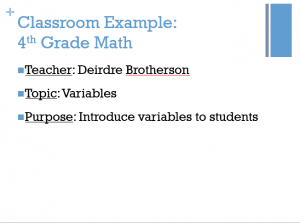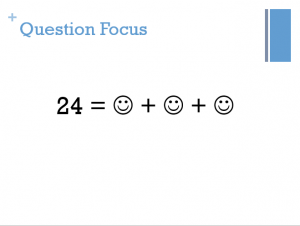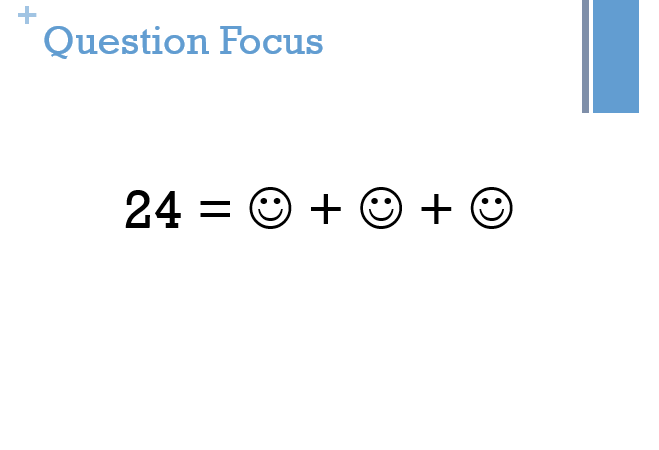an interview with Deirdre Brotherson by Mikah Farbo
Earlier this month Deirdre Brotherson, a 5th grade teacher at Hooksett Memorial School in New Hampshire, took time out of her busy day to speak with me and share her experience with the Question Formulation Technique (QFT).
Through our conversation, I learned how Brotherson’s use of the QFT helps to develop her students’ thinking skills, and that the QFT is a process that benefits both student learning and teaching instruction. When asked how the QFT impacts student thinking, Brotherson explained that the QFT, “makes them better thinkers… it expands their thought process because they’re training themselves to ask questions.” The QFT allows students to participate, ask questions, and think of new ideas, a few foundational tools for critical thinking and learning. Before she first used the QFT, she felt challenged by a lack of diverse thinking in her classrooms. Then, “after using it just a couple of times… you see a difference… you see students asking questions not only when we’re using the technique but it spills over into other parts of the day.”

As an elementary school teacher, Brotherson uses the QFT across all content areas so she sees her students asking questions throughout the school day—even when they are not using the QFT. She commented how the students, “get so interested and they have so many questions that they want to explore about things.” Yet, there is not enough time in the day to explore every question so she keeps a board in her classroom where students can write their lingering questions. Students return to their lingering questions when there is time and making students’ questions visible in the classroom is just one way that students are able to own their learning and their questions.
Brotherson observed that there is a lasting impact of the QFT on classroom culture and learning. As she continued to use the QFT the student growth became more pronounced. Brotherson sees a difference between her students and other students who have not used the QFT. She explained that the more the QFT is used, the more comfortable students are with the process because they understand the purpose and value of asking questions. She finds that her students are able to develop all types of questions, appreciate the importance of taking time to ask questions, and are able to use their questions to explore content and ideas. Students who have experienced the QFT use questions to drive their learning and place a high value on question asking in the classroom.
Much like students becoming more comfortable with the QFT, Brotherson experiences growth with her facilitation of the QFT. Having learned the QFT in 2013, Brotherson has used the technique with many classes and now leads trainings and workshops about the QFT. She shared that, “the more comfortable I get with it, the more new and different ideas I think of for how to use it.” She also emphasized how a successful implementation may look different depending on the group of students using the QFT. She explained how her first year she used the technique was successful because her students, “loved it, loved being able to grab onto something that was interesting to them.” In her second year, she had some behavioral challenges yet found the QFT to be a useful tool to help guide students autonomous learning while also allowing her to work individually with students when needed. Regardless of the student, the QFT is a learning process, “even the kids who were struggling with behaviors or academics, they got it and they really enjoyed being in control of being able to ask those questions.”

At a spring workshop focused on special education and small group learning, Brotherson was hesitant to share the QFT because she was not sure how the technique fit with special and education and small group learning. After sharing the technique, she received wonderful feedback from special education teachers who implemented the technique and found that it promoted student voice and choice.
As evidenced by Brotherson, her students, and fellow educators who she has shared the QFT with, the QFT is a simple technique that lends itself to growth and adaptability for both students and teachers. The science of the steps of the QFT and the art of the facilitative decisions teachers make when using the QFT allows for the QFT to be adapted to different student interests and needs, and eventually it leads to a different culture of learning and teaching.

Deirdre Brotherson is a fifth grade teacher at Hooksett Memorial School in New Hampshire.
Mikah Farbo is recent graduate of Harvard Graduate School of Education as well as a former Education Intern at the Right Question Institute. She looks forward to entering the classroom in September!
This blog was made possible through the support of a grant from the Sir John Templeton Foundation. The opinions expressed in this publication are those of the author(s) and do not necessarily reflect the views of the John Templeton Foundation.
